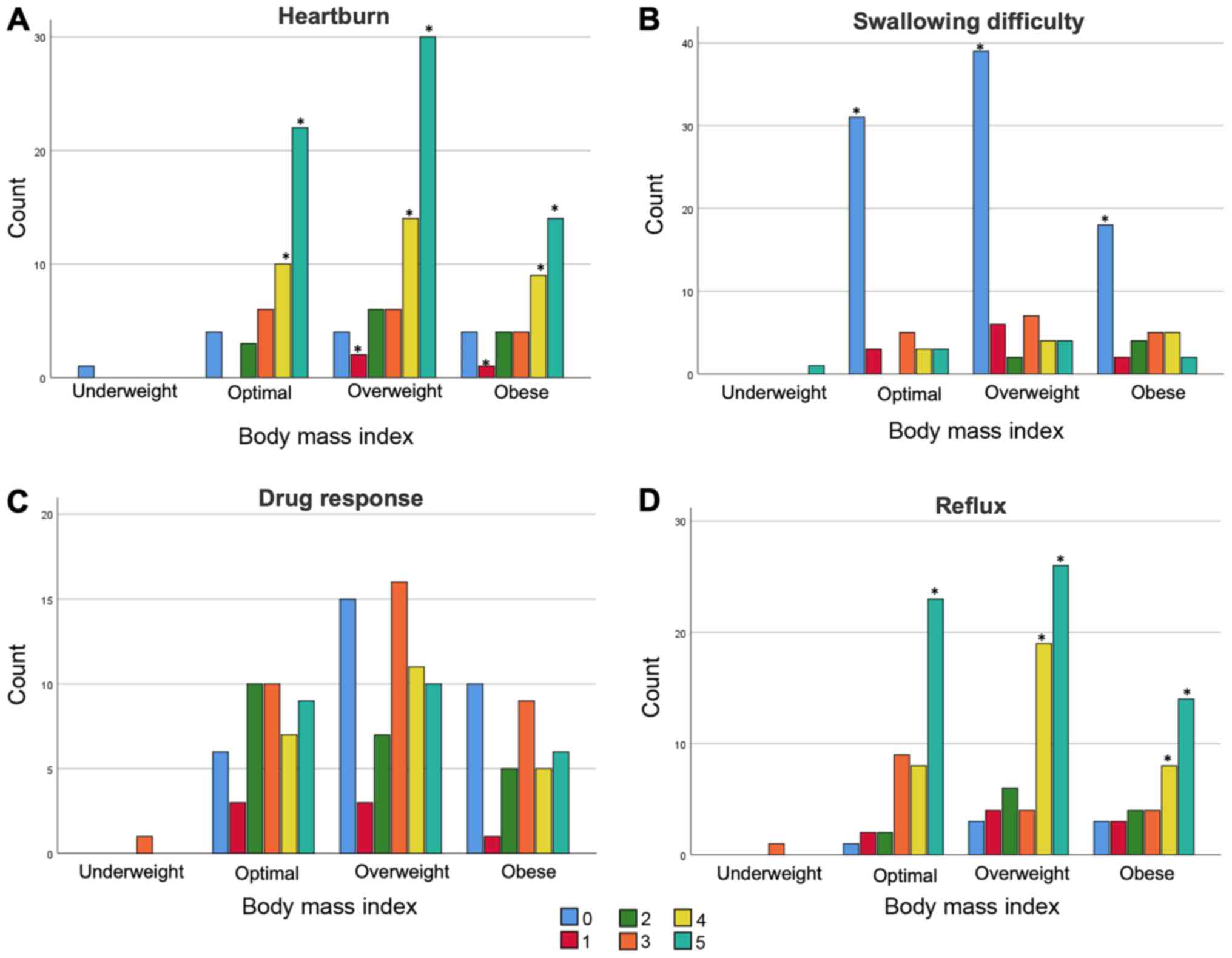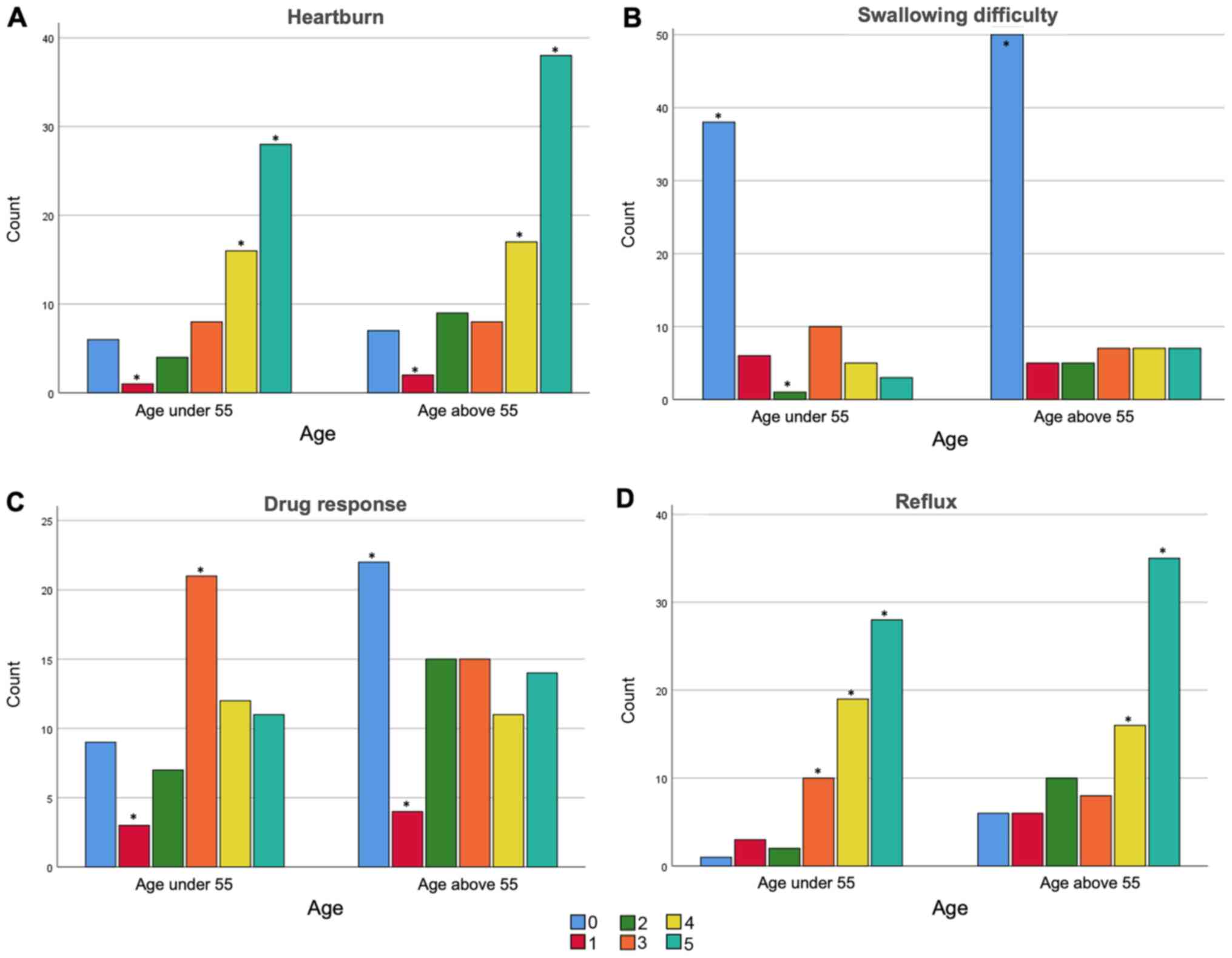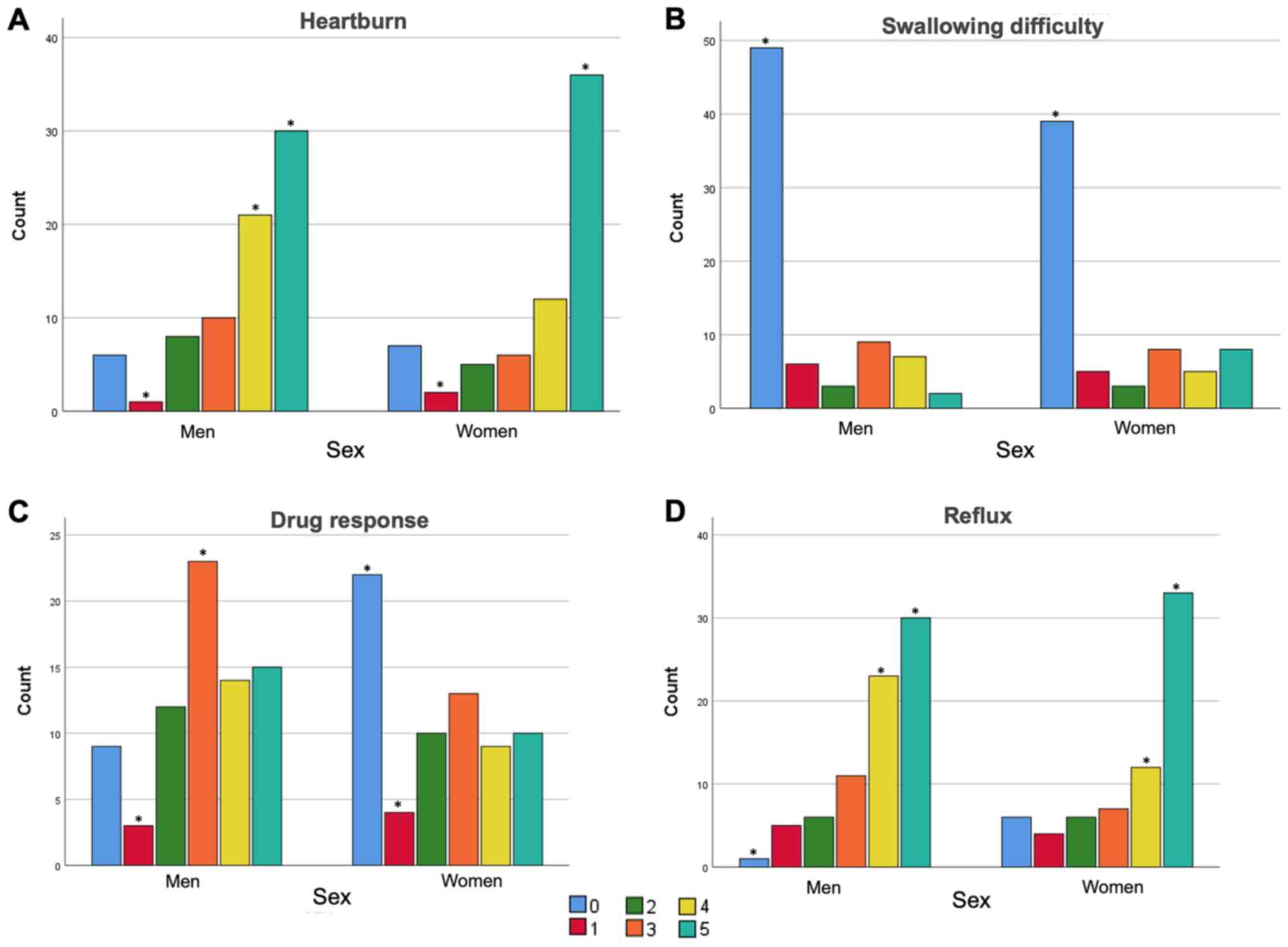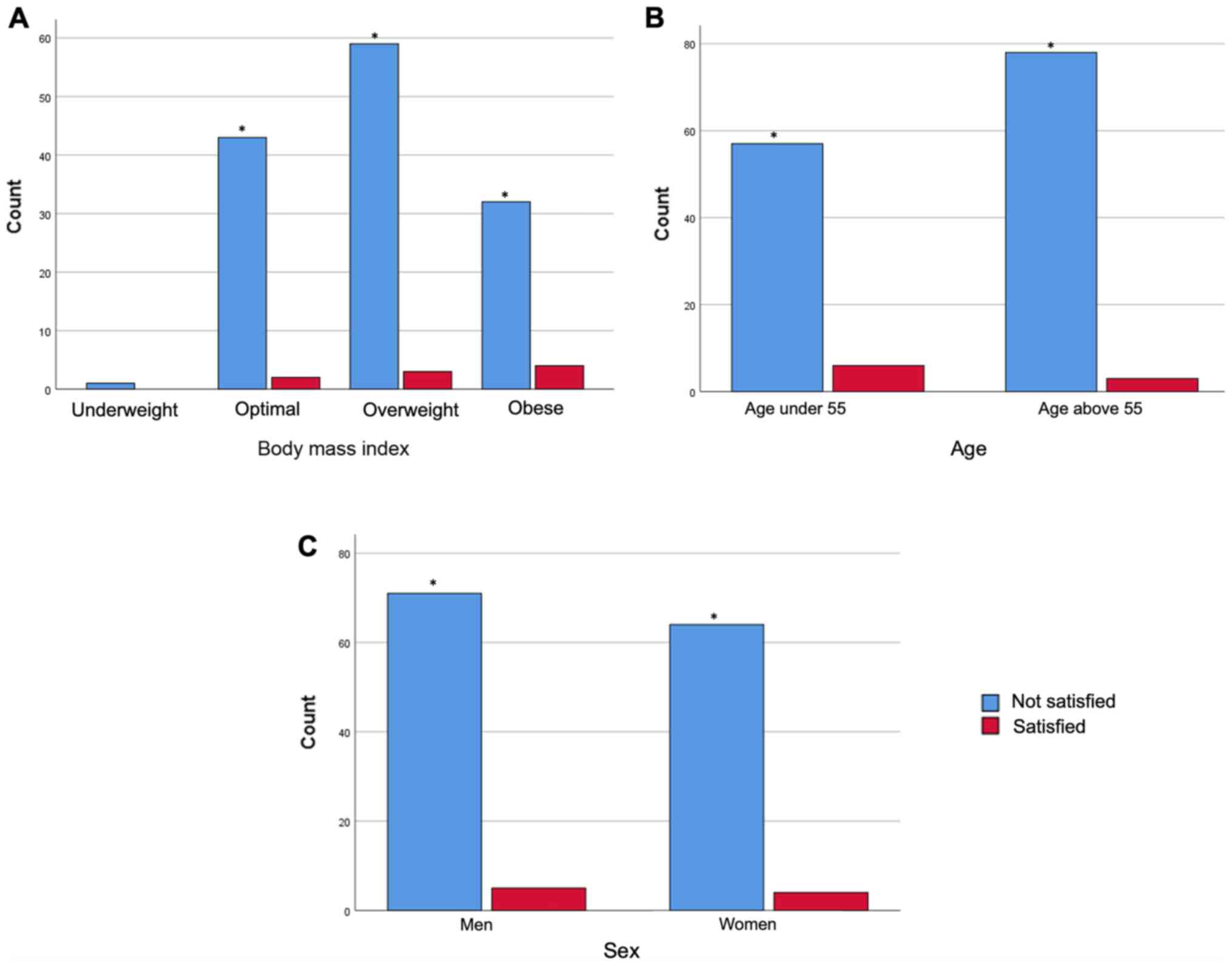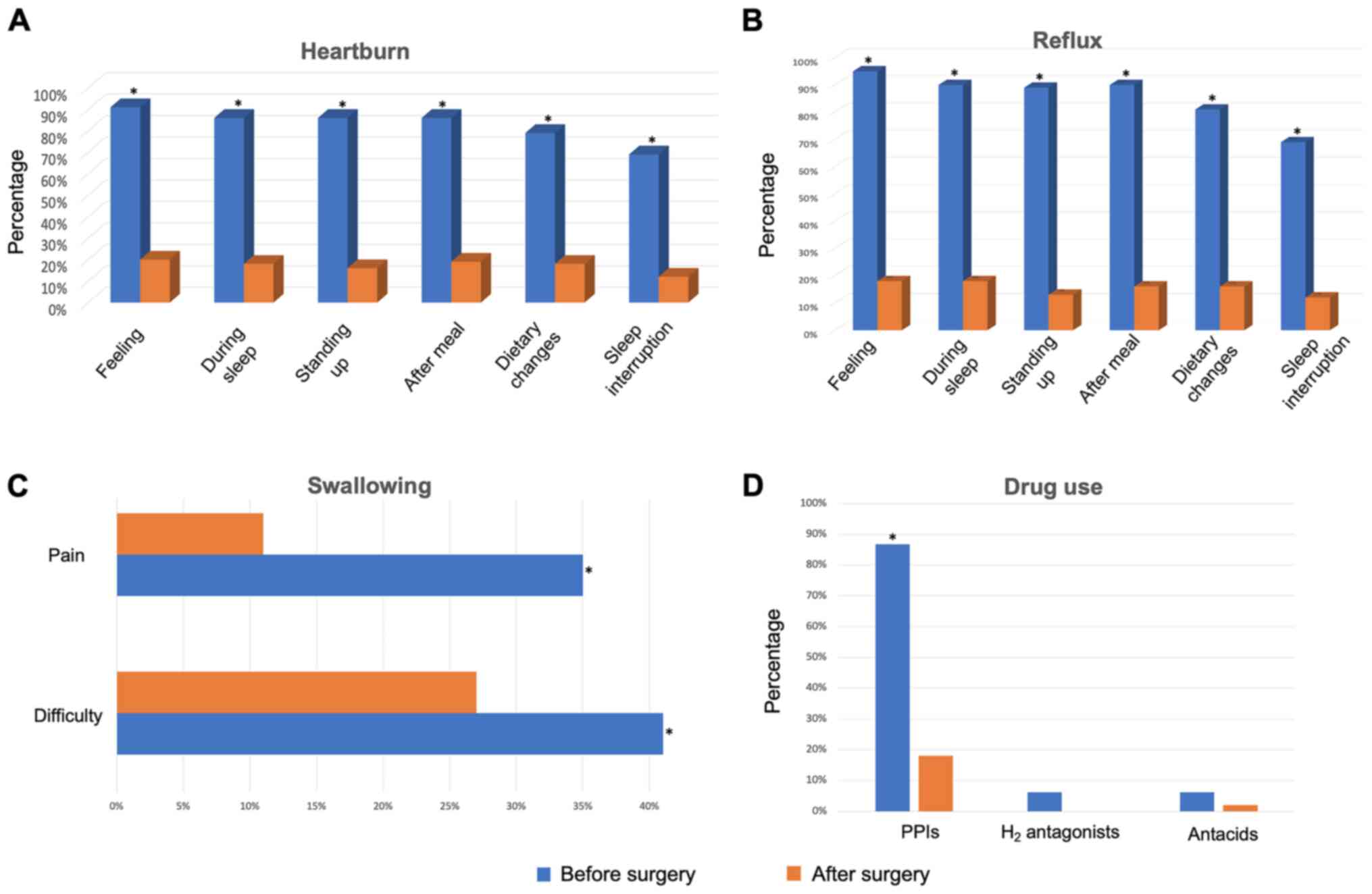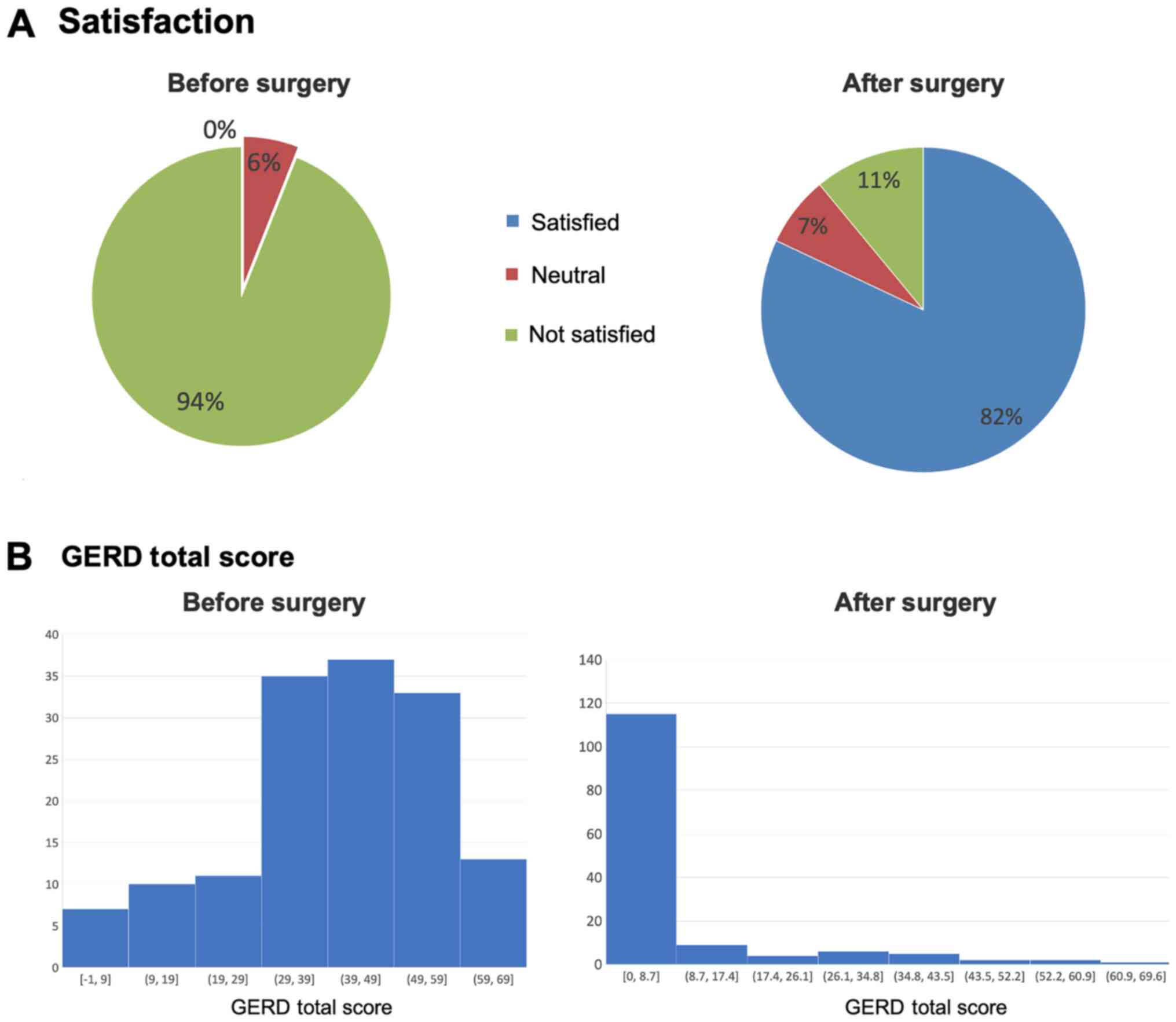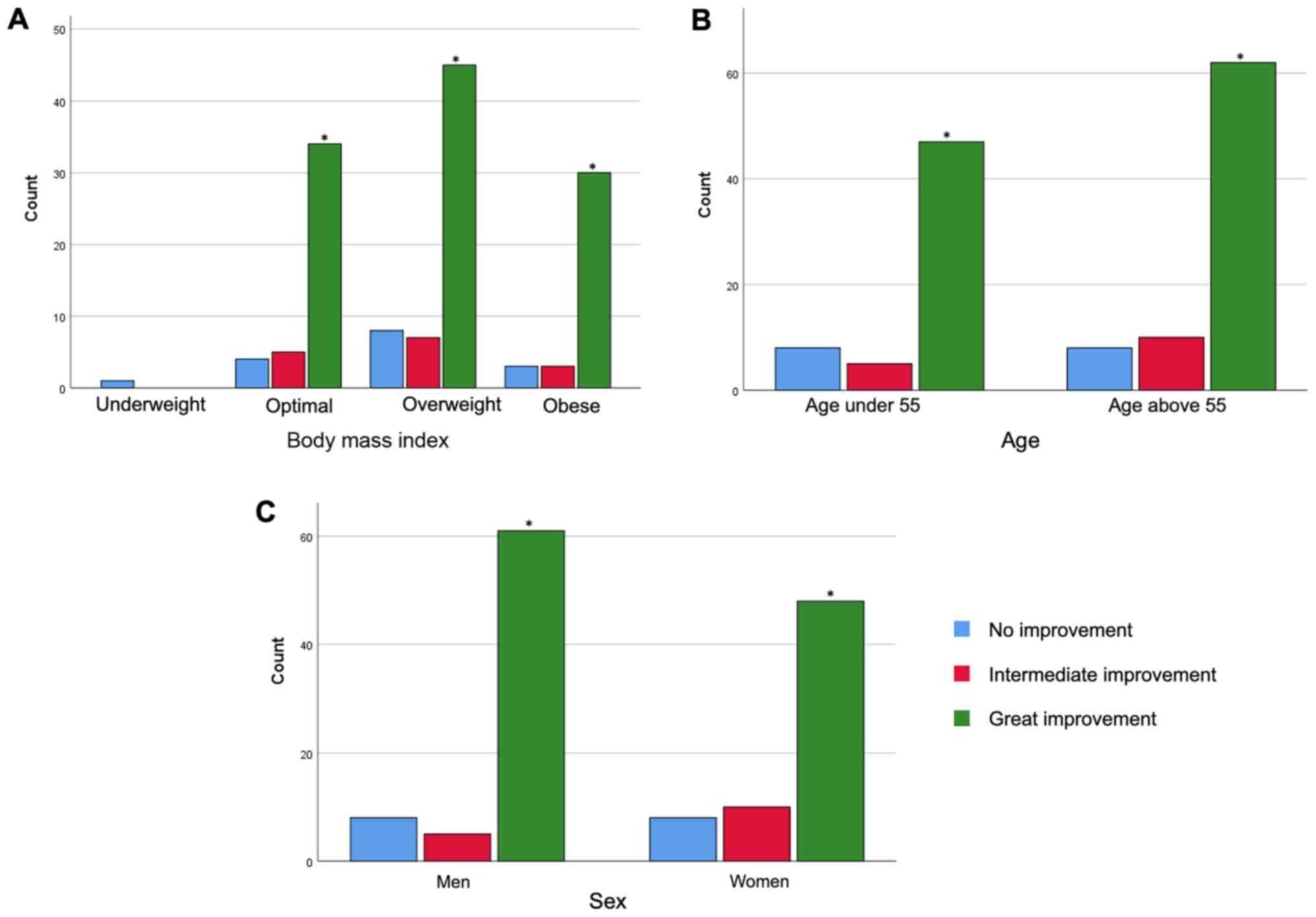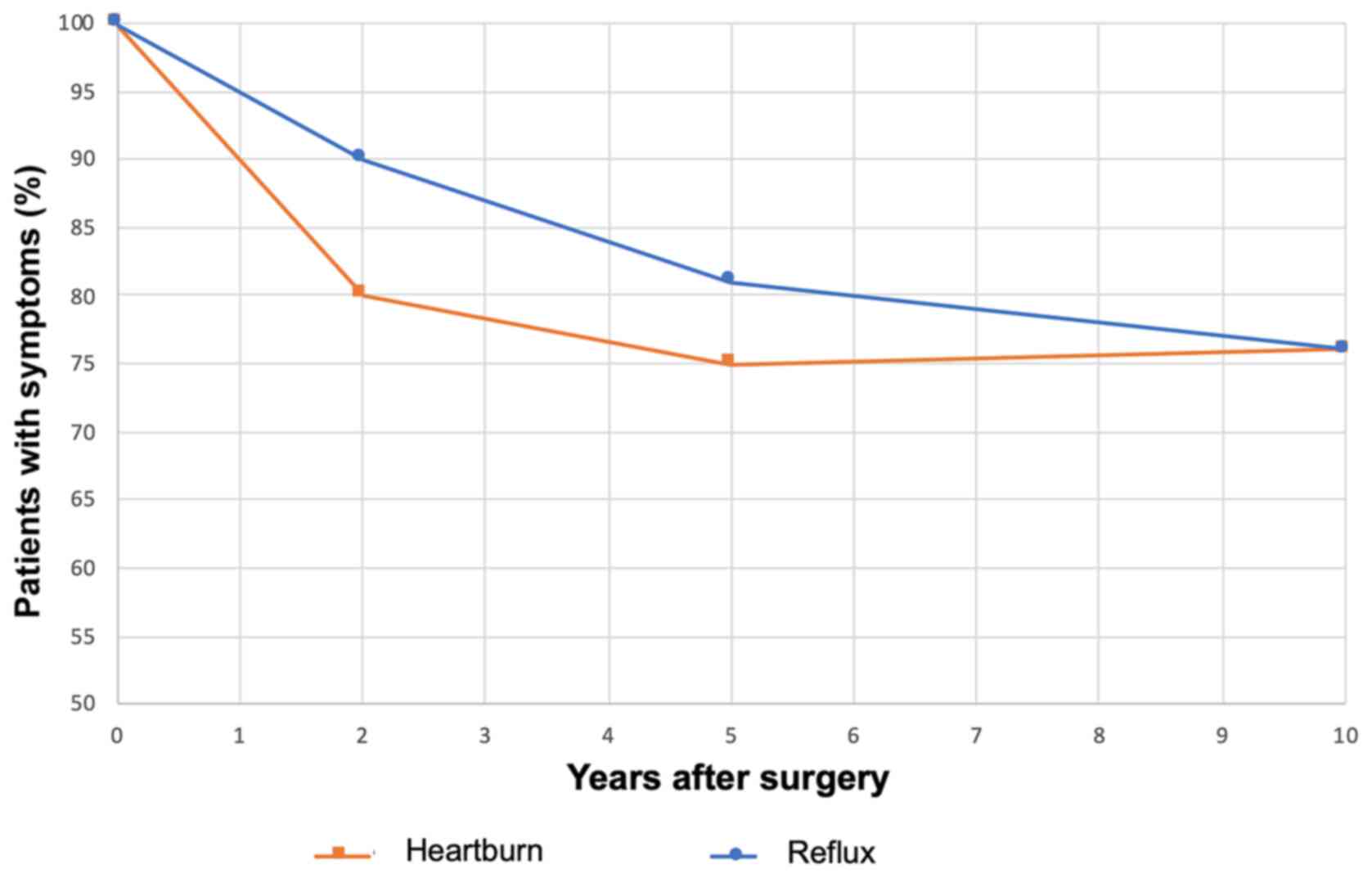Introduction
Gastroesophageal reflux disease (GERD) is a very
common disorder that affects the lower esophageal sphincter, the
muscle between the esophagus and stomach, which acts as a barrier
against reflux (1). Esophageal
peristalsis is important against reflux because it is the main
factor of esophageal cleansing, whereas dysfunctional peristalsis
is associated with severe GERD (2).
GERD is widespread; population-based studies have reported that
18-27% of the North American population, 8-25% of Europeans, 2-7%
of East Asians and 23% of South Americans suffer from GERD
(3).
The most common symptom of GERD is heartburn, and
other symptoms include swallowing difficulties and reflux (1,4,5). In
addition, acid reflux can cause bronchospasm, which can worsen
underlying asthma, leading to coughing, shortness of breath and
wheezing (6). Some patients with
GERD may also experience nausea and vomiting. It is important to
examine patients for symptoms associated with underlying
malignancy, accompanied by symptoms such as dysphagia, painful
swallowing, anemia, bleeding and weight loss. If left untreated,
GERD can cause serious complications, such as esophagitis and
Barrett's esophagus (7,8).
For diagnosis, the first step is to record patient
history to verify the symptoms, their duration, intensity and
association with specific foods, posture and exercise (5). If symptoms are temporary, empirical
treatment is provided in order to inhibit acid secretion. The
improvement of symptoms confirms the clinical existence of GERD. If
the empirical treatment does not improve symptoms, methods such as
endoscopy, esophageal pH monitoring, esophageal manometry and
barium esophagogram are used to detect secondary mucosal
complications (7).
There are some lifestyle changes that can reduce the
intensity of symptoms, including smoking cessation, reduction of
alcohol consumption, weight loss and particularly the reduction of
abdominal obesity, avoidance of fatty foods and coffee consumption,
and avoidance of eating late-night meals (5,8-16).
Posture during night sleep also appears to have a significant role
in the improvement of symptoms; a bed head higher than 15-20 cm
appears the least effective (1). If
the symptoms persist, despite the lifestyle modifications, patients
can be treated with medicines, such as antacids,
H2-histamine receptor antagonists and proton pump
inhibitors (PPIs). PPIs are the most successful pharmaceutical
treatment against GERD since they can cause rapid relief of
symptoms (17). A first-line
treatment for the improvement of GERD is the use of PPIs for 8
weeks (15). However, studies have
demonstrated that long-term and uncontrolled use of PPIs has risks,
including kidney damage, reduced absorption of nutrients (e.g., B12
and calcium), dementia and intestinal infections by Clostridium
difficile; it can also be a risk factor for stomach cancer
(17-21).
In the last two decades, laparoscopic and robotic
surgical techniques have been employed in the treatment of GERD.
Robotic surgery is a minimally invasive method that combines the
capabilities of open surgery with the advantages of laparoscopic
surgery. Such advantages of robotic surgery refer to the high
degree of freedom because of robotic arms, the visual contact of
the surgical field with a real 3D projection, and the huge
improvements in stapling and stitching, thanks to the articulated
parts of the robotic machine (22).
The aim of the present retrospective study was to
evaluate the improvement in symptoms and quality of life of
patients undergoing robotic surgery for GERD. More specifically,
the quality of life of patients was compared pre-operatively (when
they received medication to treat symptoms) and post-operatively.
GERD symptoms, such as heartburn, dysphagia and reflux, as well as
response to medications, patient satisfaction, total score for
GERD, demographics and habits, were collected and analyzed. The
potential effects of body weight, age and sex were also assessed in
the analysis. Finally, the medications received for treating GERD
symptoms were evaluated both before and after the surgery.
Materials and methods
Clinical unit
The present study was conducted at the Department of
General,-Laparoscopic, Bariatric, Robotic Surgery, Athens Medical
Center (Athens, Greece), between October 2019 and March 2020, after
ethics approval by the Scientific Committee of the Athens Medical
Center. The analysis compiled data from 144 patients who underwent
surgery to treat GERD symptoms between 2009 and 2019. For all
patients studied, robotic surgery was applied using the Nissen
fundoplication technique (23,24).
Data organization and questionnaire
encoding
Initially, the basic information about patients
(demographics, habits and surgery records) was received from the
electronic records of the hospital. After personal communication
with patients, a questionnaire was completed (25). By completing the questionnaire, pre-
and post-operative information and personal experiences were
recorded. The questions included queries about symptoms before
surgery and the medication they were receiving; the same questions
were repeated post-operatively. More specifically, patients were
asked to rate their symptoms on a scale of 0-5 as follows: 0, no
symptoms; 1, perceived symptom but not bothering; 2, perceived
symptom bothering, but not every day; 3, symptoms annoying every
day; 4, symptoms that affect daily activity; 5, symptoms that
interfere with daily activity.
In order to assess any improvement in symptoms due
to surgery, the frequency and intensity of symptoms for each
patient post-operatively were compared with those pre-operatively.
In addition, patients were asked to provide their opinion directly
on the extent of improvement by grading according to the system of
‘no improvement’, ‘intermediate’ and ‘great improvement’. In
addition, based on the individual symptoms score (for several types
of reflux, swallowing, and heartburn), the total scores for reflux
and heartburn, as well as the total GERD score, were calculated
(25).
Quality of life was assessed in two ways: i) Based
on the total score of the aforementioned questionnaire, where the
higher the score value, the worse the quality of life; ii) by
asking the patients directly if they were satisfied with their
situation with possible answers yes/no/neutral. In addition, in an
effort to assess the effects of surgery over time, patients were
divided into three categories. The first contained individuals who
had undergone surgery in the last 2 years (42 patients), the second
category of patients had undergone surgery within 5 years (49
patients), and the third category of patients had undergone surgery
up to 10 years ago (53 patients) (26). Based on this categorization, the
possibility of reflux recurrence and heartburn over time was
assessed.
Statistical analysis
Data collection was followed by statistical
processing using Excel (version 16.43 for macOS) software
(Microsoft Corporation) and the IBM® SPSS®
statistical platform (version 25; IBM Corp.). The analysis included
descriptive statistics and statistical comparisons among
groups.
Descriptive statistics
Initially, descriptive statistics were applied to
summarize the data, and provide an overview of the trends and
differences. Based on the patient scores in the questionnaire,
diagrams were developed for each symptom before and after surgery.
In addition, with the aim of investigating the role of BMI, sex and
age group (<55 or ≥55 years), data were also analyzed in terms
of these factors.
In addition, using the scores of patients, pre- and
post-operatively, graphs with differences were further developed to
assess the degree of improvement. In this case, the pre-surgery
score for each characteristic was subtracted from the corresponding
score in the follow-up period. The greater the negative change in
the score, the better the improvement of patients, i.e., reduction
of symptoms. Such diagrams were constructed for sex, age and
BMI.
Statistical comparisons
Statistical comparisons were made for all
characteristics aforementioned in the descriptive statistics
section. For all analyses, the level of significance was set to 5%;
P<0.05 was considered to indicate a statistically significant
difference. Depending on the scale of the variables (e.g., nominal,
ordinal, scale) and whether they followed normal distribution or
not, the appropriate parametric or non-parametric methods were
applied. For the group comparisons (e.g., between the two age
groups or among the several BMI categories), independent group
analyses were conducted using the symptom score value as dependent
variable and the group categories as independent variables.
Independent group analyses comprised of either the parametric
methods, independent t-test and one-way ANOVA, or the
non-parametric methods, Mann-Whitney and Kruskal-Wallis. When a
multiple comparisons method (such as ANOVA) resulted in significant
results, the post hoc group comparison methods of LSD and Tukey's
test were applied. For the comparison of symptom values before and
after surgery, the paired t-test or Wilcoxon signed rank test were
used, for parametric and non-parametric comparisons, respectively.
Comparison of proportions (namely, between two groups with count
data) was made using the independent group comparison with the
z-statistic.
Shapiro-Wilk, Kolmogorov-Smirnov and QQ plots were
used to assess normal distribution of data. Exploration of
association between two categorical variables (such as satisfaction
level and surgery) was performed using χ2 analysis.
Data confidentiality
In the present study, patient information remained
confidential in accordance with the General Data Protection
Regulation rules (Regulation 2016/679 of the European Parliament
2016) (27). Patient names were
kept confidential and remained confidential in any reproduction of
the data. Immediately after data collection, the names were deleted
from the input sheet and replaced with a unique number in a random
manner so that the patient could not be identified. Any researcher
other than the Director of the surgical team had to sign a
confidentiality statement in order to handle the data with the
names. A statement of confidentiality was not required of those who
had access to the encrypted data.
Results
Demographics
Within a period of 10 years (2009-2019), 144
patients underwent the Nissen fundoplication technique. The median
age of patients was 57.5 years, and an almost equal proportion of
men and women participated in the study (Table I). The classification of patients
according to their BMI revealed that the majority of them (68%)
were overweight and obese, whereas only a very low proportion were
underweight (0.7%) (Table I).
 | Table ICharacteristics of patients at
baseline. |
Table I
Characteristics of patients at
baseline.
|
Characteristics | Number of patients
(n=144) |
|---|
| Median age (IQR),
years | 57.5
(65-47.25) |
| Female sex, n
(%) | 68(47) |
| Male sex, n
(%) | 76(53) |
| BMI, n (%) | |
|
Underweight | 1 (0.7) |
|
Normal
weight | 45 (31.3) |
|
Overweight | 62(43) |
|
Obese | 36(25) |
Medications
Regarding the medications received for treating GERD
symptoms pre-operatively, PPIs were the most common; 86.8% of
patients took PPIs for their symptoms (Table II). Among them, esomeprazole was
the most frequently administered PPI, followed by omeprazole,
pantoprazole, rabeprazole and lastly lansoprazole (Table III). The once-a-day administration
was the most popular and was followed by 68% of patients, whereas
only a small proportion received PPIs twice a day (Table III). Some patients had more than
one daily dose regimen.
 | Table IIMedicines used to treat
gastroesophageal reflux disease symptoms before surgery. |
Table II
Medicines used to treat
gastroesophageal reflux disease symptoms before surgery.
| Medication | N (%) |
|---|
| PPIs | 125 (86.8) |
| H2
receptor antagonists | 9 (6.3) |
| Antacids | 9 (6.3) |
 | Table IIIPPI use; type of PPI and daily
dose. |
Table III
PPI use; type of PPI and daily
dose.
| Variable | N (%) |
|---|
| PPI type | |
|
Esomeprazole | 56(39) |
|
Omeprazole | 23(16) |
|
Pantoprazole | 20(14) |
|
Rabeprazole | 16(11) |
|
Lansoprazole | 10(7) |
| Daily dose of
PPI | |
|
Once a
day | 98(68) |
|
Twice a
day | 20(14) |
|
Occasionally | 13(9) |
Pre-operative findings
The most common GERD symptoms, including heartburn,
difficulty swallowing and reflux, as well as response to
medication, were examined for all patients pre-operatively. In
order to provide a more in-depth insight, these symptoms were
assessed with regards to BMI (Fig.
1), age (Fig. 2) and sex
(Fig. 3).
In the categorization based on BMI, most of the
patients from all subcategories (normal weight, overweight and
obese) reported very intense heartburn and reflux that made their
daily life difficult (Fig. 1A and
D). Very limited data were
available for underweight patients; thus, no conclusions were drawn
from them. The response to their medication ranged from moderate to
relatively high (Fig. 1C). However,
for the majority of patients from all BMI categories, difficulty
swallowing was not observed (Fig.
1B). In order to investigate whether age affected the
exhibition of symptoms, the analysis continued with the
construction of bar graphs, where patients were divided into two
age groups: Under 55 and above 55 years old (Fig. 2). For heartburn, swallowing
difficulty and reflux, a similar pattern was observed between the
two age groups, with no large differences in symptoms between young
and older patients (Fig. 2A,
B and D). Most people experienced symptoms that
interfered with their daily activity, followed by successively less
intense symptoms. It appears that younger patients suffered more
than older patients, since a much lower proportion in the younger
group did not show symptoms (Fig.
2A, B and D), whereas patients in the >55 years
group, had a poorer response to medication (Fig. 2C). The drug response in the >55
age group was moderate to deficient (Fig. 2C). With regards to statistical
comparisons, ANOVA was applied among the BMI groups, whereas
independent t-test was used to compare the two age groups and the
two sex groups. In Fig. 1, no
significant differences were revealed among the four BMI categories
(ANOVA; P>0.05). Similar results were also observed for the
comparison of scores between the two age groups in Fig. 2 (independent samples t-test;
P>0.05). The only marginal, but still not significant,
differences referred to the difference in heartburn among the BMI
groups (P=0.061) and in reflux, which was higher in the >55
years group (P=0.060).
Analysis between the sexes did not reveal
statistical differences between men and women (Fig. 3). The present study revealed that
70.6% of women and 67.1% of men had heartburn that interfered with
their daily activity (Fig. 3A). The
majority of both sexes did not experience pain at swallowing
(Fig. 3B), whereas reflux symptoms
were quite similar between men and women; 69.7% of men and 66.2% of
women exhibited severe reflux (Fig.
3D). Notably, 72% of women did not respond at all, or responded
moderately, to their medication (Fig.
3C), whereas the relevant percentage (of moderate or no
response) of men was 61.8%.
When the patients were asked about their quality of
life, the vast majority of them were dissatisfied with their daily
life, irrespective of their BMI (Fig.
4A). Similar results were observed following the separation of
patients into two groups based on their age; the vast majority of
people in both age groups were not satisfied with their quality of
life (Fig. 4B). Furthermore, no
differences were identified in terms of sex; almost all patients
reported being dissatisfied with their quality of life,
irrespective of sex (Fig. 4C).
A more detailed presentation of the impact of BMI,
age and sex on the various types and intensity of heartburn (e.g.,
discriminating when lying down, after meals etc.), swallowing pain
and reflux is provided in
Figs. S1-S9.
Post-operative changes
The present study subsequently compared the
GERD-related symptoms before and after the operation, in order to
assess the degree of improvement (Fig.
5). Notably, the feeling of heartburn improved rapidly. After
surgery, only 20% of patients still suffered from heartburn
(compared with 91% pre-operatively), 18% of people felt it during
sleep and 16% when standing up, whereas the relevant percentages
before surgery were ~90%. In addition, only 19% continued to feel
heartburn after meals, 18% still needed to make dietary changes and
12% had a problem with sleep, compared with the pre-operative
proportions of ~80% (Fig. 5A). In
addition, reflux improved just as markedly after surgery (Fig. 5B). After surgery, only 18% of
patients experienced reflux, 18% felt it during bedtime and 13%
when standing up, compared with the relevant percentages of >90%
pre-operatively. Similar pronounced improvements were observed in
the need for dietary changes and sleep without interruption.
Dysphagia and pain swallowing were also markedly improved
post-operatively (Fig. 5C), whereas
drug use was significantly reduced after surgery (Fig. 5D). Pre-operatively, the use of PPIs
reached 86.8%, and the proportion of patients using
H2-antagonists and antacids was 6.8%. However,
post-operatively, none of the patients used
H2-antagonists, whereas only 2% of them received
antacids and 18% received a PPI (Fig.
5D).
Notably, the differences in all heartburn- and
reflux-related symptoms (i.e., feeling, heartburn during sleep,
when standing up, after a meal, and whether it leads to sleep
interruption and the need for dietary changes), pain and difficulty
at swallowing, and drug use before and after surgery were
statistically significant (P<0.05; Fig. 5).
The overall quality of life of patients was also
assessed by recording their answer to the direct question of
whether they were satisfied (with answers of: Yes, no and neutral);
the results of this assessment are depicted in Fig. 6. Before surgery, the vast majority
(94%) of patients expressed their dissatisfaction about their
everyday life, whereas the proportion was inversed after surgery;
82% of patients were satisfied, 7% were neutral and only 11% were
not satisfied (Fig. 6A). The
findings were further verified when the total GERD score was
assessed. Pre-operatively, the GERD score was high, with an average
estimate of ~44; however, after surgery, GERD score was minimized
and the mean value was ~4 (Fig.
6B). This marked post-operative reduction in GERD score
reflected the pronounced improvement of patients. χ2
analysis for the comparison of the relationship between
satisfaction level and surgery (before vs. after; Fig. 6A), resulted in a significant
difference (P<0.05). In addition, when Wilcoxon statistical test
was applied to the pre- and post-operative GERD total score
(Fig. 6B), a statistically
significant difference was revealed (Table SI).
Patients were also asked to characterize the change
in how they felt before and after their operation. The extent of
improvement was assessed with regards to BMI, age group and sex
(Fig. 7). In all cases, the great
majority of patients felt great improvement in their overall life
conditions post-operatively. Much lower proportions of patients
stated no or intermediate improvement. The same findings were
observed in all situations regardless of BMI, whereas older
patients exhibited greater improvement than younger patients. Also,
even though women experienced more severe symptoms before surgery,
they appeared to respond as well as the male patients after
surgery. All types of heartburn scores, reflux scores, satisfaction
level, pain and difficulty at swallowing scores, and total GERD
score for each individual patient were compared before and after
surgery using the Wilcoxon test. In all cases, statistically
significant differences (P<0.05) were found before and after
surgery (Table SI).
Since previous results indicated a clear improvement
in all symptoms and the general condition of patients after
surgery, the two most typical symptoms of heartburn and reflux were
further assessed short-, mid- and long-term after surgery (Fig. 8). For those patients who still
experienced any level of heartburn and reflux post-operatively, the
evolution of symptoms was studied over time. It was revealed that,
as time passes, the condition of patients improved, since the
percentages of those who still felt heartburn or reflux were lower
(Fig. 8). These findings indicated
that a marked improvement was observed post-operatively and the
situation may become even better as time passes. The long-term
effectiveness of surgery was thus confirmed, even if several years
had passed.
A more detailed description of the effects of BMI,
age and sex on the differences in intensity of heartburn,
difficulty swallowing and reflux is provided in Figs.
S10-S12.
With regards to post-operative complications,
post-operative hypoxemia, blood loss and length of hospital stay
were investigated. A total of 95% of patients stayed only 1 day in
the hospital, whereas the remaining 5% stayed for 2 days. None of
the operated patients exhibited hypoxemia and no one was
transferred to the intensive care unit. In addition, there was
minimal blood loss (ca. 20 ml) in all of these GERD operations.
Discussion
In the present study, the quality of life of
patients suffering from GERD was compared pre-operatively, when the
patients received medication to treat their symptoms, and
post-operatively, in order to assess the beneficial effect of
surgery. The study took place at the Athens Medical Center, between
October 2019 and March 2020. A total of 144 patients (men and
women) who were suffering from GERD were recruited to the present
study and symptoms were evaluated post-surgery.
Based on the scores obtained from the
questionnaires, data were analyzed in terms of BMI, age group and
sex. The majority of patients in each category experienced intense
heartburn and reflux symptoms. Notably, younger patients suffered
more than older patients; however, patients in the >55 years
group, had a poorer response to medication. In addition, women
appeared to have more severe symptoms and a reduced response to
medications compared with men. Finally, quality of life, as
specified by the patients themselves, was extremely low regardless
of weight, sex and age.
The patients were re-examined after surgery and it
was revealed that the symptoms of heartburn and reflux were
markedly reduced. The majority of patients in each BMI category
were almost completely cured and a rapid improvement in quality of
life was observed. Pre-operatively, none of the patients expressed
satisfaction, whereas after the operation the percentage of
satisfied patients reached 82%. This finding is in line with other
studies reporting a relevant improvement in living standards
(28,29). Regarding the age of the patients,
the present study demonstrated that older patients exhibited better
cure rates, implying a relationship between the age of the patients
and the success of the surgery. This finding is in contrast to a
previous study, in which no similar relationship was found
(30).
In order to assess the long-term beneficial effects
of surgery, the effects of the robotic operation were studied
through the years. The desired post-operative improvement in
heartburn and reflux was maintained and the findings indicated that
the situation became slightly better over time. However, that
possible improvement over time was not found to be significant
(P=0.196, after comparing two subsequent population proportions
with the z-score). Thus, the long-term effectiveness of surgery was
confirmed for up to 10 years after surgery. Arcerito et al
(31), who performed total
fundoplication in the majority of the 50 patients recruited,
revealed that the effect of surgery on dysphagia symptoms over a
30-month median follow-up, led to very improved patient outcomes,
without mesh-related complications; a finding which was further
validated over a longer time period in the present study. It should
be clarified that in the present study, not all 144 patients were
followed post-operatively for 10 years. This implies that each
patient was uniquely classified to the short-, mid- and long-term
group simply by taking into account the date of his/her surgery at
the time the present study was conducted. Considering a stable rate
of operations over these years, the number of patients falling into
each category was almost the same.
The present study also assessed the medications
administered to treat GERD. The first-line treatment of GERD
symptoms are drugs that modify the pH of the stomach, such as PPIs.
In the present study, PPIs were revealed to be the predominant
medication received by the patients (86.8%); among them,
esomeprazole was the most commonly used. After surgery, only 18% of
patients made occasional use of a PPI and only 2% used antacids.
These findings are in line with other studies showing that low
proportions of patients use PPIs 10 years after surgery, whereas
medication use after surgery is a poor indicator of recurrent GERD
(28,29). This is in contrast with other
studies reporting significantly higher rates of PPI use
post-operatively (25,32).
The objective of the present study was to assess the
symptoms (heartburn, dysphagia and reflux) of patients with GERD
and the administered medications, and to evaluate their quality of
life before and after robotic surgery using the Nissen
fundoplication technique. A retrospective study was conducted on
144 patients who underwent surgery and their data were
statistically analyzed. The potential impact of BMI, age and sex
were further investigated. All patients involved in this analysis
were exhibited pre-operatively severe symptoms of heartburn, reflux
and low quality of life. All of these symptoms were re-examined
after the surgery, where a marked decrease was observed in their
frequency and intensity. Post-operative patient satisfaction and
quality of life were very high, and more than 4/5 of patients
declared high satisfaction. Improvement was not found to be
affected by BMI, whereas older patients exhibited relatively
greater improvement compared to younger people. Although women
initially experienced more severe symptoms before surgery, they
appeared to respond as well to surgery as male patients. The
long-term beneficial effect of robotic surgery for up to the
10-year period studied was validated. Additional randomized
clinical trials, using increased sample sizes, are required to
verify these interesting findings.
Supplementary Material
Intensity of heartburn before surgery
stratified by body mass index category (underweight, optimal,
overweight and obese). Heartburn (A) when lying down, (B) when
standing up, (C) after meals and (D) leading to sleep interruption.
The intensity of heartburn was ranked from 0 (no symptoms) to 5
(highest intensity).
Intensity of pain at swallowing before
surgery stratified by body mass index category (underweight,
optimal, overweight and obese). The intensity of pain was ranked
from 0 (no symptoms) to 5 (highest intensity).
Intensity of reflux before surgery
stratified by body mass index category (underweight, optimal,
overweight and obese). Reflux (A) when lying down, (B) when
standing up, (C) after meals and (D) leading to sleep interruption.
The intensity of reflux was ranked from 0 (no symptoms) to 5
(highest intensity).
Intensity of heartburn before surgery
stratified by age group (under 55 years or above 55 years).
Heartburn (A) when lying down, (B) when standing up, (C) after
meals and (D) leading to sleep interruption. The intensity of
reflux was ranked from 0 (no symptoms) to 5 (highest
intensity).
Intensity of pain at swallowing before
surgery stratified by age group (under 55 years or above 55 years).
The intensity of pain was ranked from 0 (no symptoms) to 5 (highest
intensity).
Intensity of reflux before surgery
stratified by age group (under 55 years or above 55 years). Reflux
(A) when lying down, (B) when standing up, (C) after meals and (D)
leading to sleep interruption. The intensity of reflux was ranked
from 0 (no symptoms) to 5 (highest intensity).
Intensity of heartburn before surgery
stratified by sex. (A) when lying down, (B) when standing up, (C)
after meals and (D) leading to sleep interruption. The intensity of
reflux was ranked from 0 (no symptoms) to 5 (highest
intensity).
Intensity of pain at swallowing before
surgery stratified by sex. The intensity of pain was ranked from 0
(no symptoms) to 5 (highest intensity).
Intensity of reflux before surgery
stratified by sex. Reflux (A) when lying down, (B) when standing
up, (C) after meals and (D) leading to sleep interruption. The
intensity of reflux was ranked from 0 (no symptoms) to 5 (highest
intensity).
Difference in the intensity of GERD
symptoms before and after surgery, stratified by body mass index
category (underweight, optimal, overweight, obese). GERD symptoms
refer to (A) heartburn, (B) difficulty swallowing and (C) reflux.
The difference in the intensity of symptoms is defined as intensity
of symptom after surgery minus intensity of symptom before surgery.
Negative values indicate improvement, whereas positive values
exhibit worsening. Zero refers to no change in symptom intensity;
-5 refers to the highest degree of improvement. GERD,
gastroesophageal reflux disease.
Difference in the intensity of GERD
symptoms before and after surgery, stratified by age group (under
55 years or above 55 years). GERD symptoms refer to (A) heartburn,
(B) difficulty swallowing and (C) reflux. The difference in the
intensity of symptoms is defined as intensity of symptom after
surgery minus intensity of symptom before surgery. Negative values
indicate improvement, whereas positive values exhibit worsening.
Zero refers to no change in symptom intensity; -5 refers to the
highest degree of improvement. GERD, gastroesophageal reflux
disease.
Difference in the intensity of GERD
symptoms before and after surgery, stratified by sex. GERD symptoms
refer to (A) heartburn, (B) difficulty swallowing and (C) reflux.
The difference in the intensity of symptoms is defined as intensity
of symptom after surgery minus intensity of symptom before surgery.
Negative values indicate improvement, whereas positive values
exhibit worsening. Zero refers to no change in symptom intensity;
-5 refers to the highest degree of improvement. GERD,
gastroesophageal reflux disease.
Results of Wilcoxon test comparing the
symptoms before and after surgery.
Acknowledgements
Not applicable.
Funding
No funding was received.
Availability of data and materials
The datasets generated and/or analyzed during the
current study are not publicly available due to the confidentiality
of clinical data but are available from the corresponding author on
reasonable request.
Authors' contributions
SKK, VK and KK conceived and designed the
experiments. PK and GEA performed the experiments. PK, GEA, and KK
confirmed authenticity of raw data. PK and GEA drafted the
manuscript. SKK, PK, GEA, SLM, VK and KK finalized the manuscript.
SKK supervised the experiments. PK, GEA and VK performed data
analysis and interpretation. SKK, SLM and KK verified the results
of the experiments, helped with the statistical analysis and
revised the manuscript critically for intellectual content. All
authors read and approved the final manuscript.
Ethics approval and consent to
participate
The present study was approved by the Scientific
Committee of the Athens Medical Center. All patients provided oral
consent before providing their answers to the questionnaire.
Patient consent for publication
Not applicable.
Competing interests
The authors declare that they have no competing
interests.
References
|
1
|
Mittal RK: Pathophysiology of
gastroesophageal reflux disease: Motility factors. In: The
Esophagus. Castell DO and Richter J (eds). Lippincott Williams
& Wilkins, Philadelphia, PA, pp407-420, 2004.
|
|
2
|
Diener U, Patti MG, Molena D, Fisichella
PM and Way LW: Esophageal dysmotility and gastroesophageal reflux
disease. J Gastrointest Surg. 5:260–265. 2001.PubMed/NCBI View Article : Google Scholar
|
|
3
|
El-Serag HB, Sweet S, Winchester CC and
Dent J: Update on the epidemiology of gastro-oesophageal reflux
disease: A systematic review. Gut. 63:871–880. 2014.PubMed/NCBI View Article : Google Scholar
|
|
4
|
Bredenoord AJ, Weusten BL, Curvers WL,
Timmer R and Smout AJ: Determinants of perception of heartburn and
regurgitation. Gut. 55:313–318. 2006.PubMed/NCBI View Article : Google Scholar
|
|
5
|
Katz PO, Gerson LB and Vela MF: Guidelines
for the diagnosis and management of gastroesophageal reflux
disease. Am J Gastroenterol. 108:308–328; quiz 329. 2013.PubMed/NCBI View Article : Google Scholar
|
|
6
|
Irwin RS, French CL, Curley FJ, Zawacki JK
and Bennett FM: Chronic cough due to gastroesophageal reflux.
Clinical, diagnostic, and pathogenetic aspects. Chest.
104:1511–1517. 1993.PubMed/NCBI View Article : Google Scholar
|
|
7
|
Richter JE, Pandolfino JE, Vela MF,
Kahrilas PJ, Lacy BE, Ganz R, Dengler WB, Oelschlager PJ, DeVault
KR, Fass R, et al: Esophageal Diagnostic Working Group. Utilization
of wireless pH monitoring technologies: a summary of the
proceedings from the esophageal diagnostic working group. Dis
Esophagus. 26:755–65. 2013.PubMed/NCBI View Article : Google Scholar
|
|
8
|
Kaltenbach T, Crockett S and Gerson LB:
Are lifestyle measures effective in patients with gastroesophageal
reflux disease? An evidence-based approach. Arch Intern Med.
166:965–971. 2006.PubMed/NCBI View Article : Google Scholar
|
|
9
|
Ness-Jensen E and Lagergren J: Tobacco
smoking, alcohol consumption and gastro-oesophageal reflux disease.
Best Pract Res Clin Gastroenterol. 31:501–508. 2017.PubMed/NCBI View Article : Google Scholar
|
|
10
|
Hunt R, Armstrong D, Katelaris P, Afihene
M, Bane A, Bhatia S, Chen MH, Choi MG, Melo AC, Fock KM, et al:
Review Team. World Gastroenterology Organisation Global Guidelines:
GERD global perspective on gastroesophageal reflux disease. J Clin
Gastroenterol. 51:467–478. 2017.PubMed/NCBI View Article : Google Scholar
|
|
11
|
Bou Daher H and Sharara AI:
Gastroesophageal reflux disease, obesity and laparoscopic sleeve
gastrectomy: The burning questions. World J Gastroenterol.
25:4805–4813. 2019.PubMed/NCBI View Article : Google Scholar
|
|
12
|
Mejía-Rivas MA, Herrera-López A,
Hernández-Calleros J, Herrera MF and Valdovinos MA:
Gastroesophageal reflux disease in morbid obesity: The effect of
Roux-en-Y gastric bypass. Obes Surg. 18:1217–1224. 2008.PubMed/NCBI View Article : Google Scholar
|
|
13
|
Gu L, Chen B, Du N, Fu R, Huang X, Mao F,
Khadaroo PA and Zhao S: Relationship between bariatric surgery and
gastroesophageal reflux disease: A systematic review and
meta-analysis. Obes Surg. 29:4105–4113. 2019.PubMed/NCBI View Article : Google Scholar
|
|
14
|
Newberry C and Lynch K: The role of diet
in the development and management of gastroesophageal reflux
disease: Why we feel the burn. J Thorac Dis. 11 (Suppl
12):S1594–S1601. 2019.PubMed/NCBI View Article : Google Scholar
|
|
15
|
Moraes-Filho JP, Navarro-Rodriguez T,
Barbuti R, Eisig J, Chinzon D and Bernardo W: Brazilian Gerd
Consensus Group. Guidelines for the diagnosis and management of
gastroesophageal reflux disease: An evidence-based consensus. Arq
Gastroenterol. 47:99–115. 2010.PubMed/NCBI View Article : Google Scholar
|
|
16
|
Khan BA, Sodhi JS, Zargar SA, Javid G,
Yattoo GN, Shah A, Gulzar GM and Khan MA: Effect of bed head
elevation during sleep in symptomatic patients of nocturnal
gastroesophageal reflux. J Gastroenterol Hepatol. 27:1078–1082.
2012.PubMed/NCBI View Article : Google Scholar
|
|
17
|
MacFarlane B: Management of
gastroesophageal reflux disease in adults: A pharmacist's
perspective. Integr Pharm Res Pract. 7:41–52. 2018.PubMed/NCBI View Article : Google Scholar
|
|
18
|
Freedberg DE, Kim LS and Yang YX: The
risks and benefits of long-term use of proton pump inhibitors:
Expert review and best practice advice from the American
Gastroenterological Association. Gastroenterology. 152:706–715.
2017.PubMed/NCBI View Article : Google Scholar
|
|
19
|
Thomson AB, Sauve MD, Kassam N and
Kamitakahara H: Safety of the long-term use of proton pump
inhibitors. World J Gastroenterol. 16:2323–2330. 2010.PubMed/NCBI View Article : Google Scholar
|
|
20
|
Haastrup PF, Thompson W, Søndergaard J and
Jarbøl DE: Side effects of long-term proton pump inhibitor use: A
review. Basic Clin Pharmacol Toxicol. 123:114–121. 2018.PubMed/NCBI View Article : Google Scholar
|
|
21
|
Cheung KS and Leung WK: Long-term use of
proton-pump inhibitors and risk of gastric cancer: A review of the
current evidence. Therap Adv Gastroenterol: Mar 11, 2019 (Epub
ahead of print). doi: 10.1177/1756284819834511.
|
|
22
|
Hartmann J, Jacobi CA, Menenakos C, Ismail
M and Braumann C: Surgical treatment of gastroesophageal reflux
disease and upside-down stomach using the Da Vinci robotic system.
A prospective study. J Gastrointest Surg. 12:504–509.
2008.PubMed/NCBI View Article : Google Scholar
|
|
23
|
Ceccarelli G, Romano A, Esposito G, De
Rosa M, Bugiantella W, Miranda E, Fontani A and D'Andrea V:
Robot-assisted Toupet fundoplication and associated cholecystectomy
in symptomatic giant hiatal hernia with situs viscerum inversus - A
case report and literature review. Int J Surg Case Rep. 60:371–375.
2019.PubMed/NCBI View Article : Google Scholar
|
|
24
|
Georgiou E, Schoina E, Markantonis SL,
Karalis V, Athanasopoulos PG, Chrysoheris P, Antonakopoulos F and
Konstantinidis K: Laparoscopic total extraperitoneal inguinal
hernia repair: Retrospective study on prosthetic materials,
postoperative management, and quality of life. Medicine
(Baltimore). 97(e13974)2018.PubMed/NCBI View Article : Google Scholar
|
|
25
|
Castelijns PS, Ponten JE, Vd Poll MC,
Bouvy ND and Smulders JF: Quality of life after Nissen
fundoplication in patients with gastroesophageal reflux disease:
Comparison between long- and short-term follow-up. J Minim Access
Surg. 14:213–220. 2018.PubMed/NCBI View Article : Google Scholar
|
|
26
|
Mahawar KK: Defining short-term,
medium-term, long-term, and very long-term follow-up after
bariatric surgery. Obes Surg. 28:1425–1426. 2018.PubMed/NCBI View Article : Google Scholar
|
|
27
|
Regulation (EU) 2016/679 of the European
Parliament and of the Council of 27 April 2016 on the protection of
natural persons with regard to the processing of personal data and
on the free movement of such data, and repealing Directive
95/46/EC. OJEU. 119:1–88. 2016.
|
|
28
|
Dallemagne B, Weerts J, Markiewicz S,
Dewandre JM, Wahlen C, Monami B and Jehaes C: Clinical results of
laparoscopic fundoplication at ten years after surgery. Surg
Endosc. 20:159–165. 2006.PubMed/NCBI View Article : Google Scholar
|
|
29
|
Morgenthal CB, Shane MD, Stival A, Gletsu
N, Milam G, Swafford V, Hunter JG and Smith CD: The durability of
laparoscopic Nissen fundoplication: 11-year outcomes. J
Gastrointest Surg. 11:693–700. 2007.PubMed/NCBI View Article : Google Scholar
|
|
30
|
Lee TG, Lee IS, Kim BS, Jung HY and Choi
YB: Surgical outcomes and over one-year follow-up results of
laparoscopic Nissen fundoplication for gastroesophageal reflux
disease: Single-center experiences. Asian J Surg. 42:557–562.
2019.PubMed/NCBI View Article : Google Scholar
|
|
31
|
Arcerito M, Changchien E, Falcon M, Parga
MA, Bernal O and Moon JT: Robotic fundoplication for
gastroesophageal reflux disease and hiatal hernia: Initial
experience and outcome. Am Surg. 84:1945–1950. 2018.PubMed/NCBI
|
|
32
|
Spechler SJ, Lee E, Ahnen D, Goyal RK,
Hirano I, Ramirez F, Raufman JP, Sampliner R, Schnell T, Sontag S,
et al: Long-term outcome of medical and surgical therapies for
gastroesophageal reflux disease: Follow-up of a randomized
controlled trial. JAMA. 285:2331–2338. 2001.PubMed/NCBI View Article : Google Scholar
|















